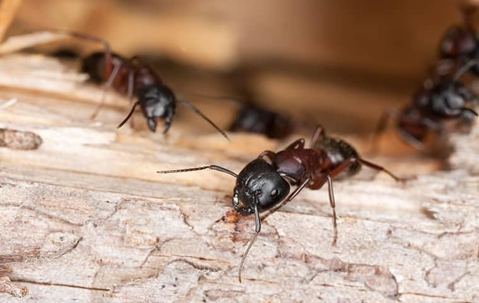What Are the Signs of a Carpenter Ant Infestation?
Carpenter ants dig tunnels and create nests in wood. They usually target lumber, logs, and tree bark that’s damp or decaying. Cracks and crevices around foundations, vents, utility lines, and wires are typical entry points for them. To get across roof-lines, these pests will navigate overhanging tree branches. Once they’re successfully inside your home or business, they will concentrate on the kitchen to get to the meat and sugary food they enjoy. They also munch on other bugs, so having carpenter ants suggests an overall pest problem. The bases and walls of your property will become unstable, as carpenter ants shred wood from the inside and work their way out. Cosmetically, things will be undesirable. Though these insects move at a slower speed than termites, the destruction can be just as severe and costly. Most people won’t realize the ants have invaded until it’s too late. You may only see them if you knock on a wall; doing so makes them shuffle out in a panic. This is why keeping your eyes open for the following indicators is important:
- Seeing piles of ant body parts and wood shavings
- Finding discarded, scaly wings from swarmers
- Hearing noises behind walls, like rustling and clicking
- Having walls that sound hollow
Larger than most, carpenter ants are 1/4 to 1/2 inch long. A good number of them are orange, brown, tan, or yellow, but many are reddish-black, black, or red. Workers and swarmers in the colony have particular traits: the big front mandibles of workers help them grind wood, and swarmers are winged, which is how they leave nests during the mating season. They’re drawn to light, so you might spot them by fixtures.
How Can You Prevent Carpenter Ants?
Perform these tasks to keep carpenter ants at bay:
- Seal openings around paneling, foundations, windows, doors, and utilities.
- Put weather stripping and sweeps on windows and doors.
- Repair all moisture faults and leaks, especially those impacting wood.
- Remove rotting wood and trees.
- Use containers with tight lids for trash and food.
- Vacuum and wash dishes on a routine basis.
- Distance loose wood and greenery from exterior doors.
- Call Big D Pest & Termite if you have other pests that carpenter ants consume.
What Can Big D Pest & Termite Do About Carpenter Ants?
Carpenter ants require in-depth and unique solutions only Big D Pest & Termite can provide. Our licensed technicians will apply our effective home pest treatments to affected areas, eliminating active ant colonies and preventing future ones from developing. Our cost-effective plans include interior and exterior care, same-day and follow-up visits, specialty services, guarantees, and more. Our flexibility is part of why we have a high rating with the Better Business Bureau. You’ll receive a free quote when you call today!

